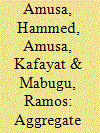|
|
|
Sort Order |
|
|
|
Items / Page
|
|
|
|
|
|
|
| Srl | Item |
| 1 |
ID:
091702


|
|
|
|
|
| Publication |
2009.
|
| Summary/Abstract |
Electricity demand in South Africa has grown at a very rapid rate over the past decade. As part of reform initiatives to enhance long-term sustainability of the country's electricity industry, South Africa's authorities have in recent years sought to develop an electricity pricing framework that is cost reflective and forms the cornerstone of demand management schemes meant to foster changes in consumption behaviour and enhance efficiency in resource use. The effects of any pricing policy on aggregate electricity consumption will depend on a useful understanding of the factors that influence electricity demand, and the magnitude to which electricity demand responds to changes in such factors. In this context, this paper applies the bounds testing approach to cointegration within an autoregressive distributed lag framework to examine the aggregate demand for electricity in South Africa during the period 1960-2007. The results indicate that in the long run, income is the main determinant of electricity demand. With electricity prices having an insignificant effect on aggregate electricity demand, future pricing policies will need to ensure that electricity prices are cost reflective and enhance efficiency of electricity supply and use.
|
|
|
|
|
|
|
|
|
|
|
|
|
|
|
|
| 2 |
ID:
150382


|
|
|
|
|
| Summary/Abstract |
The deep economic crisis and the sharp rise in electricity prices have reduced electricity demand by Spanish households. This paper aims to analyse the responsiveness of household electricity demand and the welfare effects related to both factors in the 2006–2012 period by applying a demand model estimated with the quantile regression method. The results show that the electricity consumption of medium-high income households is particularly responsive to price increases, whereas that of medium-low income households is more responsive to changes in income. The retail electricity price increases and the economic crisis have led to lower and steeper U-shape price elasticities of demand and higher and steeper N-shape income elasticities of demand. The joint impact of those two factors on the welfare of lower-income households is higher in relative terms (i.e., as a share of household income) than for other income groups. These results suggest that the economic crisis and increases in retail electricity prices have had detrimental welfare effects, especially on the lower-income segment of the population. They should be considered when financing climate and energy policies through the electricity bill and provide a rationale to take such support, which pushes the retail electricity price upwards, out of the electricity bill.
|
|
|
|
|
|
|
|
|
|
|
|
|
|
|
|
| 3 |
ID:
115128


|
|
|
|
|
| Publication |
2012.
|
| Summary/Abstract |
Electricity demand forecasting could prove to be a useful policy tool for decision-makers; thus, accurate forecasting of electricity demand is valuable in allowing both power generators and consumers to make their plans. Although a seasonal ARIMA model is widely used in electricity demand analysis and is a high-precision approach for seasonal data forecasting, errors are unavoidable in the forecasting process. Consequently, a significant research goal is to further improve forecasting precision. To help people in the electricity sectors make more sensible decisions, this study proposes residual modification models to improve the precision of seasonal ARIMA for electricity demand forecasting. In this study, PSO optimal Fourier method, seasonal ARIMA model and combined models of PSO optimal Fourier method with seasonal ARIMA are applied in the Northwest electricity grid of China to correct the forecasting results of seasonal ARIMA. The modification models forecasting of the electricity demand appears to be more workable than that of the single seasonal ARIMA. The results indicate that the prediction accuracy of the three residual modification models is higher than the single seasonal ARIMA model and that the combined model is the most satisfactory of the three models.
|
|
|
|
|
|
|
|
|
|
|
|
|
|
|
|
| 4 |
ID:
094878


|
|
|
|
|
| Publication |
2010.
|
| Summary/Abstract |
The production and consumption of electricity is a major source of CO2 emissions in Europe and elsewhere. In turn, the manufacturing sectors are significant end-users of electricity. In contrast to most papers in the literature, which focus on the supply-side, this study tackles the demand-side of electricity. An input-output approach combined with a sensitivity analysis has been developed to analyse the direct and indirect consumptions of electricity by eighteen manufacturing sectors in fifteen European countries, with indirect electricity demand related to the purchase of industrial products from other sectors which, in turn, require the consumption of electricity in their manufacturing processes. We identify the industrial transactions and sectors, which account for a greater share of electricity demand. In addition, the impact of an electricity price increase on the costs and prices of manufacturing products is simulated through a price model, allowing us to identify those sectors whose manufacturing costs are most sensitive to an increase in the electricity price.
|
|
|
|
|
|
|
|
|
|
|
|
|
|
|
|
| 5 |
ID:
092582


|
|
|
|
|
| Publication |
2009.
|
| Summary/Abstract |
In this paper, we test for asymmetric behaviour of industrial and residential electricity demand for the G7 countries, using the entropy-based test for symmetry suggested by [Racine, J., and Maasoumi, E., 2007. A versatile and robust metric entropy test of time-reversibility, and other hypotheses. Journal of Econometrics 138(2), 547-567; Racine, J., and Maasoumi, E., 2008. A robust entropy-based test of asymmetry for discrete and continuous processes. Econometric Reviews 28, 246-261], the Triples test of [Randles, R., Flinger, M., Policello, G., and Wolfe, D., 1980. An asymptotically distribution-free test for symmetry versus asymmetry. Journal of the American Statistical Association 75, 168-172] and the [Bai, J., and Ng, S., 2001. A consistent test for conditional symmetry in time series models. Journal of Econometrics 103, 225-258] test for conditional symmetry. Using data that spans over three decades, we find overwhelming evidence of conditional symmetry of residential and industrial electricity consumption. This finding implies that the use of econometric tests based on linear data generating processes is credible.
|
|
|
|
|
|
|
|
|
|
|
|
|
|
|
|
| 6 |
ID:
094936


|
|
|
|
|
| Publication |
2010.
|
| Summary/Abstract |
Climate change affects the need for heating and cooling. This paper examines the impact of gradually warming climate on the need for heating and cooling with an econometric multivariate regression model for five countries in Europe along the south-north line. The predicted changes in electricity demand are then used to analyze how climate change impacts the cost of electricity use, including carbon costs. Our main findings are, that in Central and North Europe, the decrease in heating due to climate warming, dominates and thus costs will decrease for both users of electricity and in carbon markets. In Southern Europe climate warming, and the consequential increase in cooling and electricity demand, overcomes the decreased need for heating. Therefore costs also increase. The main contributors are the role of electricity in heating and cooling, and the climatic zone.
|
|
|
|
|
|
|
|
|
|
|
|
|
|
|
|
| 7 |
ID:
175893


|
|
|
|
|
| Summary/Abstract |
In this paper, we examine the electrification of the heating sector as a decarbonisation strategy, discuss its effectiveness, and preliminary assess its impact on the European power system. For this purpose, we perform a complete description of the EU heating sector compliant with official statistics and decompose the EU power demand in different uses to define and assess different levels of heat electrification. We find that heat electrification is an effective decarbonisation option, which can reduce the total energy related emissions by up to 17%, if paired with simultaneous expansion of low-carbon energy. Due to the relative sizes of heat and power demands, we find that most national power systems could cope with higher heat-electrification rates. Specifically, an additional heat pump capacity in the order of 1.1–1.6 TWth can be deployed based on the existing firm power capacity, which would correspond to a heat pump share of 29–45% in space heating. Based on their current power capacity, 12 Member States are prepared for even full electrification scenarios, whereas three Member States could get their power system stressed if 40–60% of all fossil-fuelled technologies are substituted. Flexible electric demand is identified as a key enabler of larger heat electrification shares.
|
|
|
|
|
|
|
|
|
|
|
|
|
|
|
|
| 8 |
ID:
179700


|
|
|
|
|
| Summary/Abstract |
The introduction of Time of Use (ToU) tariffs may affect residential electricity consumers differently depending not only on their financial position but also time availability. The aim of this paper is to identify socio-demographic groups which may be financially advantaged or disadvantaged by the introduction of ToU tariffs. Assuming no behavioural change, we impose ToU tariffs on UK half hourly smart meter data and the synthetic demand profiles for different household composition generated using the 2014–2015 UK Time Use Survey data and optimisation of energy consumption per activity against the smart meter data. The distributional effects of ToU tariffs are obtained for customer segmentation and socio-demographic groups, and presented in terms of peak to off-peak ratios and impacts on the synthetic demand profiles. Findings on the distributional effects of ToU tariffs reveal regional differences (e.g. positive effects for high income groups in London) and household composition similarities (e.g. positive effects for households with children not in the high-income group).
|
|
|
|
|
|
|
|
|
|
|
|
|
|
|
|
| 9 |
ID:
126621


|
|
|
|
|
| Publication |
2013.
|
| Summary/Abstract |
In Korea, price subsidies for industrial power are provided by the government in order to enhance industrial competitiveness and curb inflation. However, this repeatedly causes electricity shortages in the peak summer and winter seasons because of over-consumption. Forcing a decline in the demand for electricity by raising power rates would thus help prevent a national blackout, lowering dependence on foreign energy and reducing CO2 emissions cost-effectively. This paper simulates the effects of a rise in power rate on demand for electricity and output price by estimating a restricted cost function, in which the quantity of raw materials is set to its cost-minimizing level, jointly with an inverse supply relation for the top three electricity-intensive manufacturing sectors. The empirical results indicate that a 10% increase in electricity rate would result in 8.0-10.1% less demand across all three manufacturing sectors, ceteris paribus. The impact on output price is of little statistical significance in the basic metals sector, while output price on average falls by 0.16% in the TV and communication equipment sector.
|
|
|
|
|
|
|
|
|
|
|
|
|
|
|
|
| 10 |
ID:
179722


|
|
|
|
|
| Summary/Abstract |
The coronavirus pandemic (COVID-19) has led to a massive collapse in economic activity and energy demand, with the result of significant emissions reductions at a global scale. However, the existing literature investigating abatement from COVID-19 mainly overlooked the overwhelming emissions reduction in Europe's power sector. We address this by assessing the intricate relationship between electricity demand shocks and heterogeneous generation technologies in the power sectors of 16 major European economies during January to March 2020. We apply an econometric model in an instrumental-variables framework. In a first step, we assess the impact of COVID-19 infections on electricity demand, and in a second step how this translates into emissions abatement. We find that, during full lockdown, COVID-19 reduced electricity demand by 19% and carbon emissions by an astonishing 34% per hour, whereas there is severe country heterogeneity depending on the electricity supply structure and demand shock intensity. From our estimates, we predict that power sector emissions fell by 18.4% in 2020. Our results reveal the importance of a carbon price, so that a demand reduction can offset large amounts of emissions by displacing coal at the margin. We derive several policy implications from our analysis to draw lessons from the pandemic.
|
|
|
|
|
|
|
|
|
|
|
|
|
|
|
|
| 11 |
ID:
113483


|
|
|
|
|
| Publication |
2012.
|
| Summary/Abstract |
This paper examines the global electricity demand in Tunisia as a function of gross domestic product in constant price, the degree of urbanization, the average annual temperature, and the real electricity price per Kwh. This demand will be examined employing annual data over a period spanning almost thirty one years from 1976 to 2006. A long run relationship between the variables under consideration is determined using the Vector Autoregressive Regression. The empirical results suggest that the electricity demand in Tunisia is sensitive to its past value, any changes in gross domestic product and electricity price. The electricity price effects have a negative impact on long-run electricity consumption. However, the gross domestic product and the past value of electricity consumption have a positive effect. Moreover, the causality test reveals a unidirectional relationship between price and electricity consumption. Our empirical findings are effective to policy makers to maintain the electricity consumption in Tunisia by using the appropriate strategy.
|
|
|
|
|
|
|
|
|
|
|
|
|
|
|
|
| 12 |
ID:
171468


|
|
|
|
|
| Summary/Abstract |
In this article, we investigate the heterogeneity in the responsiveness of Swiss household electricity demand to changes in prices and income. We focus on segments of consumers with different intensities of electricity consumption by using a panel quantile regression approach. This estimation strategy is applied to a rich micro-level longitudinal data set of 3880 observations from more than 1400 households, matched with a unique price data set extracted from the Swiss electricity regulator's online sources. While the findings show an inelastic electricity demand across all groups, an interesting pattern of variation emerges between lower and upper quantiles of electricity demand, respectively frugal and intensive users. Results show that households in the first conditional quartile and at the median react significantly to changes in prices, while those at the lowest quantile and upper quantiles exhibit insignificant price elasticities. The main policy implications of this work concern the design of price-based measures for reducing electricity consumption in the residential sector and the possibility of accounting for individual responses in tailoring policies for specific consumer segments.
|
|
|
|
|
|
|
|
|
|
|
|
|
|
|
|
| 13 |
ID:
109624


|
|
|
|
|
| Publication |
2011.
|
| Summary/Abstract |
This paper explores wind power integration issues for the South Australian (SA) region of the Australian National Electricity Market (NEM) by assessing the interaction of regional wind generation, electricity demand and spot prices over 2 recent years of market operation. SA's wind energy penetration has recently surpassed 20% and it has only a limited interconnection with other regions of the NEM. As such, it represents an interesting example of high wind penetration in a gross wholesale pool market electricity industry. Our findings suggest that while electricity demand continues to have the greatest influence on spot prices in SA, wind generation levels have become a significant secondary influence, and there is an inverse relationship between wind generation and price. No clear relationship between wind generation and demand has been identified although some periods of extremely high demand may coincide with lower wind generation. Periods of high wind output are associated with generally lower market prices, and also appear to contribute to extreme negative price events. The results highlight the importance of electricity market and renewable policy design in facilitating economically efficient high wind penetrations.
|
|
|
|
|
|
|
|
|
|
|
|
|
|
|
|
| 14 |
ID:
127230


|
|
Impact on electricity demand and emissions due to the introduct
/ Dias, Marcos Vinícius Xavier; Haddad, Jamil; Nogueira, Luiz Horta; Bortoni, Edson da Costa, Cruz, Ricardo Alexandre Passos da, Yamachita, Roberto Akira, Goncalves, Jose Luiz
|

|
|
|
|
| Publication |
2014.
|
| Summary/Abstract |
Over the past years, the pursuit of using less polluting energy sources throughout society has been on the increase. In general, the transportation sector is responsible for most of the emissions of greenhouse gases. Therefore, in this article a methodological approach is applied in such a way that it is possible to quantify the impact of the penetration of electric vehicles vis-à-vis others that use different types of fuel (flexible fuel, for example). The study is conducted for a road modal in São Paulo, the main state in Brazil in terms of economy, energy and environment, taking into account only automobiles. A comparative analysis of forecasting scenarios until 2035 for various inputs of electric cars in the whole state fleet is presented, aiming to verify the susceptibility of the model suggested, upon the introduction of electric vehicles, taking into account also the electrical and environmental impacts related to it. The analysis was possible due to the use of a simulation tool, Long range Energy Alternatives Planning System (LEAP), which is an energy environmental model based on scenarios, allowing an integrated and reliable support to develop studies on integrated energy planning.
|
|
|
|
|
|
|
|
|
|
|
|
|
|
|
|
| 15 |
ID:
109435


|
|
|
|
|
| Publication |
2011.
|
| Summary/Abstract |
Cointegration and vector error correction modeling approaches are widely used in electricity demand analysis. The study rigorously examines the determinants of electricity demand at aggregate and sectoral levels in Pakistan. In the backdrop of severe electricity shortages, our empirical findings give support to the existence of a stable long-run relationship among the variables and indicate that electricity demand is elastic in the long run to both income and price at aggregate level. At sectoral level, long-run income and price elasticity estimates follow this pattern except in agricultural sector, where electricity demand is found elastic to output but inelastic to electricity price. On the contrary, the coefficients for income and price are rather small and mostly insignificant in the short run. We employed temperature index, price of diesel oil and capital stock at aggregate and sectoral levels as exogenous variables. These variables account for most of the variations in electricity demand in the short run. It shows that mechanization of the economy significantly affect the electricity demand at macro level. Moreover, elastic electricity demand with respect to electricity price in most of the sectors implies that electricity price as a policy tool can be used for efficient use and conservation.
|
|
|
|
|
|
|
|
|
|
|
|
|
|
|
|
| 16 |
ID:
177403


|
|
|
|
|
| Summary/Abstract |
Using monthly account level data for over 27,000 households between 2007 and 2014, this study evaluates a revenue neutral municipal electricity conservation program. Rebates for the purchase of energy efficient appliances were financed via a small surcharge on high consuming households. The results demonstrate that the program mainly transferred money between residents with almost no effect on electricity consumption. Using variation in the timing of the rebate checks, none of the energy efficiency incentives yielded a statistically or economically meaningful reduction in electricity consumption compared with a counterfactual where no rebate was offered. Using a bunching estimator and exploiting changes in behavior around the high consumption threshold, a small reduction in electricity consumption is attributable to the surcharge, suggesting that prices are better than subsidies at reducing electricity consumption. Overall, the change in behavior attributable to the electricity conservation program is small, supporting recent evidence that many energy efficiency programs underperform in real-world settings.
|
|
|
|
|
|
|
|
|
|
|
|
|
|
|
|
| 17 |
ID:
115186


|
|
|
|
|
| Publication |
2012.
|
| Summary/Abstract |
The three-tier inclining block tariff ("IBT") issued by the Chinese government in 2010 is focusing attention of energy economists, among whom Lin and Jiang (2012. Designation and influence of household increasing block electricity tariffs in China. Energy Policy 42, 164-173) who assert that the issued tariff is unsuited to meet the social and environmental objectives it was designed for. These authors offer an alternative four-tiered IBT, the performance of which they show by evaluating its welfare and income distribution effects taking the current uniform tariff as reference. To measure the surplus loss to a representative household in a given block the authors use the trapezoid approach. But, because of the limited data on demand, they calculate the household's response by using a constant point estimate of the own-price elasticity of electricity demand. In this note I show there is an incompatibility between these two modeling assumptions. Combining them is causing an upward bias in the surplus loss, which is of significance given the large price change associated with the IBT. I then offer a correction to this bias.
|
|
|
|
|
|
|
|
|
|
|
|
|
|
|
|
| 18 |
ID:
171436


|
|
|
|
|
| Summary/Abstract |
The last decade was marked by a new boom of popularity for electric transport. Massive government support helped increase EV annual sales from just 2 to over 753 thousands worldwide over the ten years. Many countries and private enterprises hold extremely high hopes for electric transport, predicting the imminent abandonment of the internal combustion engines (ICE). Our research shows that in 2018 EVs are yet still unable to compete on equal footing with conventional cars. However, should government and auto manufacturers maintain the current pace of development, true competitiveness between ICE and electric vehicles can be achieved by 2035 even in the low-oil-price environment.
Our calculations indicate that by 2040, depending on the scenario, the EVs can secure an 11–28% share of the global road transport fleet. This will lead to an additional increase in global electricity consumption of 11–20%. The challenge, however, is the adaptation of power grid to the growing demand peaks due to EVs charging patterns. To maintain the course on “green” energy, global leaders in EV adoption need to double the efforts on development and implementation of energy storage technologies, otherwise, the spread of electric cars will lead to more fossil fuel consumption.
|
|
|
|
|
|
|
|
|
|
|
|
|
|
|
|
| 19 |
ID:
125702


|
|
|
|
|
| Publication |
2013.
|
| Summary/Abstract |
The geological conditions in Greece contributed to the creation of important low-enthalpy geothermal energy resources (LEGERs). The resources are divided into low, medium and high enthalpy, or temperature, based on criteria that are generally based on the energy content of the fluid. LEGERs are those sources of the hot water whose temperature is between 25 and 100 °C, which are used for heating residences and in the agricultural or industrial sector. The investigation for the exploitation of low-enthalpy geothermal fluids, which began around 1980, intensified in the last two decades. The low-enthalpy geothermal potential in Greece is rather significant as most of the geothermal fields have been found in regions with favourable developmental conditions, and it seems that they do not present serious environmental or technical exploitation problems. LEGER areas are abundant in Greece, mainly in the eastern and northern part of the country, as well as in many of the Aegean Islands. The aim of this work is to review the options for managing wind load by using low-enthalpy geothermal energy for electricity (through heat pump utilisation) according to the local energy demand.
|
|
|
|
|
|
|
|
|
|
|
|
|
|
|
|
| 20 |
ID:
125488


|
|
|
|
|
| Publication |
2013.
|
| Summary/Abstract |
As policy regime changes, demand elasticities are unlikely to be constant since individuals change how they form their expectations, and this will change the estimated decision rules. In this paper, the time-varying nature of electricity demand elasticities prior to and post the economic reform period in Ghana is analysed using the FM-OLS. Three different sample periods -pre-reform, post-reform, and full-period- was used in the analysis. The result from the full-sample period revealed that in the long-run electricity demand is significantly affected by industry efficiency, industry value added, and real per capita GDP. Urbanization rate, however, has no significant effect. The pre-reform estimate showed lower income, output, and urbanization elasticities but higher industry energy efficiency elasticity relative to the post-reform period. This suggests that technological change in the pre-reform period has been energy saving whilst technological change in the post reform period has been energy consuming. The result further showed evidence of changing structure of the economy from the more energy intensive sector to the less energy intensive sector after the reform. Government should renew her effort in promoting energy saving technologies in the industrial sector and adjust the industrial structure to encourage the expansion of low energy intensive industries or high technology efficient industries.
|
|
|
|
|
|
|
|
|
|
|
|
|
|
|
|
|
|
|
|
|